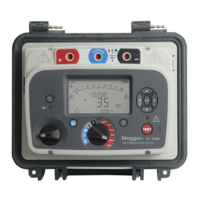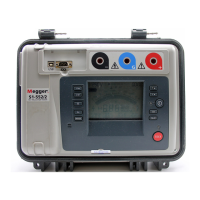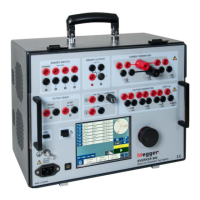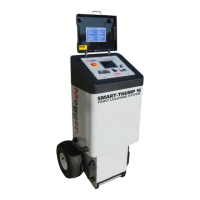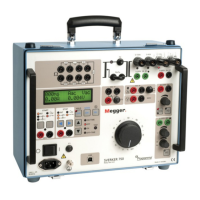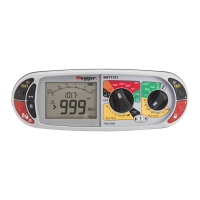1. SAFETY WARNINGS
G Safety warnings must be observed during use:
The circuit under test must be switched off, de-energised, isolated and checked to be safe before insulation test
connections are made. Make sure the circuit is not reenergised whilst the instrument is connected.
Only 15 kV rated Megger test leads with plug inserts of 75 mm must only be used on the S1-1568. Lead
integrity can be verified by momentarily shorting clips together at the lowest test voltage range.
Circuit terminals must not be touched during an insulation test or when the test LED is flashing to indicate a
hazardous condition on the measurement circuit, before suitable grounding of the unit under test is in place in
line with safe working practices.
When powered by battery and with the mains supply disconnected, the pins on the mains socket may be
electrostatically charged to a high voltage. There is not enough energy for this to be hazardous but, to reduce
discomfort from accidental discharge if the mains inlet plug is touched, it is strongly recommended that the
functional earth terminal is connected to a convenient earth or unipotential protection circuit. The user is fully
protected for safety by double insulation and this connection need not be capable of taking a fault current.
After completing a test, capacitive circuits must be completely discharged before disconnecting the test leads.
Capacitive charges can be lethal.
Tested items must be firmly shorted out with a shorting link, after discharge, until required for use. This is to
guard against any stored dielectric absorption charge subsequently being released thereby raising the voltage to
potentially dangerous levels.
The voltage indicator and automatic discharge features must be regarded as additional safety features and not a
substitute for normal safe working practice.
It is rare, but in certain circumstances, breakdown of the circuit under test may cause the instrument to
terminate the test in an uncontrolled manner, possibly causing a loss of display while the circuit remains
energised. In this event, the unit must be turned off and the circuit discharged manually.
Test leads, including crocodile clips, must be in good order, clean and with no broken or cracked insulation.
The instrument must not be used if any part of it is damaged.
Insulation testing in wet conditions might be hazardous. It is recommended that this instrument is not used in
these circumstances. If this is unavoidable, the user must take all necessary precautions.
This instrument is not intrinsically safe and must not be used in hazardous atmospheres.
If this equipment is used in a manner not specified by the manufacturer, the protection provided by the
equipment may be impaired.
A test can be started at any time via remote control. Measurement connections must be handled only with the
remote control indicator beacon removed from its socket.
In the event of the instrument failing in remote control mode the test must be stopped manually by pressing the
TEST button.
If performing a two-wire test without guard using the S1-1068, insert the blue safety plug.
Switch the instrument OFF and disconnect any AC source, measurement leads, and all other equipment before
opening the case to change the battery. The instrument must not be operated with the case open. DANGER!
Hazardous voltages are exposed with an AC source connected and the case open.
www.megger.com
S1-568 / S1-1068 / S1-1568
2
SAFETY WARNINGS

